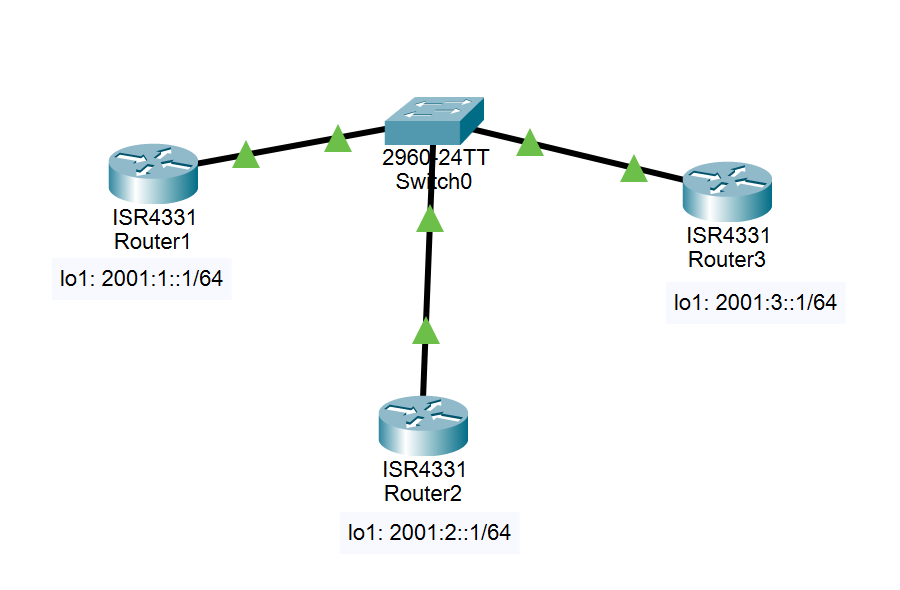# 15:IPv6环境的OSPFv3实验
# 实验要求
分别在路由器R1、R2、R3上配置三个环回接口,分别配置三个全球单播范围内的IPv6地址,模拟三个不同的IPv6前缀(类似于IPv4的子网)
在三台路由器上启动OSPFv3,最后来观察IPv6的路由学习结果,查看OSPFv3的邻居关系等。
# 实验拓扑

# 实验过程
- 完成路由器R1、R2、R3的Ipv6的基础配置
包括启动IPv6和配置IPv6的接口地址,激活接口,具体配置如下
路由器 R1 的基础配置:
//启动IPv6路由功能
Router1(config)#ipv6 unicast-routing
Router1(config)#int g0/0/0
//在接口下启动IPv6,将自动生成本地链路地址
Router1(config-if)#ipv6 enable
Router1(config-if)#no shut
Router1(config-if)#int lo1
Router1(config-if)#ipv6 address 2001:1::1/64
1
2
3
4
5
6
7
8
2
3
4
5
6
7
8
路由器 R2的基础配置:
Router2(config)#ipv6 unicast-routing
Router2(config)#int g0/0/0
Router2(config-if)#ipv6 enable
Router2(config-if)#no shut
Router2(config-if)#int lo1
Router2(config-if)#ipv6 address 2001:2::1/64
1
2
3
4
5
6
2
3
4
5
6
路由器R3的基础配置:
Router3(config)#ipv6 unicast-routing
Router3(config)#int g0/0/0
Router3(config-if)#ipv6 enable
Router3(config-if)#no shut
Router3(config-if)#int lo1
Router3(config-if)#ipv6 address 2001:3::1/64
1
2
3
4
5
6
2
3
4
5
6
- 启动OSPFv3路由协议
在路由器R3的OSPFv3配置:
//启动OSPFv3的路由进程1
Router3(config)#ipv6 router ospf 1
%OSPFv3-4-NORTRID: OSPFv3 process 1 could not pick a router-id,please configure manually
//为OSPFv3配置路由器ID(RID)
Router3(config-rtr)#router-id 3.3.3.3
Router3(config)#int g0/0/0
//使该接口加入到OSPFv3进程1并申明区域为0
Router3(config-if)#ipv6 ospf 1 area 0
Router3(config)#int lo1
Router3(config-if)#ipv6 ospf 1 area 0
1
2
3
4
5
6
7
8
9
10
11
12
2
3
4
5
6
7
8
9
10
11
12
注意:在配置OSPFv3时,必须为路由器进程配置路由器ID(RID)这与OSPFv2完全不同,在OSPFv2的环境中,RID是一个可选项配置,但是在OSPFv3的环境中RID是必须配置,否则OSPFv3将无法启动。OSPFv3的RID将仍然以点分十进制的方法显示,比如:1.1.1.1这很像IPv4地址的表达方式。
在路由器R2的OSPFv3配置:
Router2(config-if)#ipv6 router ospf 1
%OSPFv3-4-NORTRID: OSPFv3 process 1 could not pick a router-id,please configure manually
Router2(config-rtr)#
Router2(config-rtr)#router-id 2.2.2.2
Router2(config-rtr)#int g0/0/0
Router2(config-if)#ipv6 ospf 1 area 0
Router2(config-if)#int lo1
Router2(config-if)#ipv6 ospf 1 area 0
1
2
3
4
5
6
7
8
2
3
4
5
6
7
8
在路由器R1的OSPFv3配置:
Router1(config-if)#ipv6 router ospf 1
%OSPFv3-4-NORTRID: OSPFv3 process 1 could not pick a router-id,please configure manually
Router1(config-rtr)#router-id 1.1.1.1
Router1(config-rtr)#int g0/0/0
Router1(config-if)#ipv6 ospf 1 area 0
Router1(config-if)#int lo1
Router1(config-if)#ipv6 ospf 1 area 0
1
2
3
4
5
6
7
2
3
4
5
6
7
- 检查OSPFv3邻居关系的状态、路由学习的情况,以及连通性检测
可以使用 show ipv6 ospf neighbor 来查看OSPFv3的邻居关系正常,如下所示,并且可知路由器R3是DR路由器,R2是BDR路由器,关于为什么这样选举,在OSPFv2中有详细描述,这里不再重复描述。然后可以通过 show ipv6 route 查看路由器R1的IPv6路由表,如下所示,可看出R1成功的学习到了路由器R2和R3公告出来的OSPF路由,其中的“O”就表示通过OSPFv3所学到的路由。最后在路由器R1上通过ping指令检测与路由器R2和R3上相关IPv6前缀的连通性,一切正常。
查看OSPF的邻居关系:
Router1#show ipv6 ospf neighbor
Neighbor ID Pri State Dead Time Interface ID Interface
3.3.3.3 1 FULL/DR 00:00:32 1 GigabitEthernet0/0/0
2.2.2.2 1 FULL/BDR 00:00:34 1 GigabitEthernet0/0/0
1
2
3
4
5
2
3
4
5
查看IPv6路由表:
Router1#show ipv6 route
IPv6 Routing Table - 5 entries
Codes: C - Connected, L - Local, S - Static, R - RIP, B - BGP
U - Per-user Static route, M - MIPv6
I1 - ISIS L1, I2 - ISIS L2, IA - ISIS interarea, IS - ISIS summary
ND - ND Default, NDp - ND Prefix, DCE - Destination, NDr - Redirect
O - OSPF intra, OI - OSPF inter, OE1 - OSPF ext 1, OE2 - OSPF ext 2
ON1 - OSPF NSSA ext 1, ON2 - OSPF NSSA ext 2
D - EIGRP, EX - EIGRP external
C 2001:1::/64 [0/0]
via Loopback1, directly connected
L 2001:1::1/128 [0/0]
via Loopback1, receive
O 2001:2::1/128 [110/1]
via FE80::202:16FF:FEE6:1001, GigabitEthernet0/0/0
O 2001:3::1/128 [110/1]
via FE80::2D0:BCFF:FE49:8101, GigabitEthernet0/0/0
L FF00::/8 [0/0]
via Null0, receive
1
2
3
4
5
6
7
8
9
10
11
12
13
14
15
16
17
18
19
2
3
4
5
6
7
8
9
10
11
12
13
14
15
16
17
18
19
在路由器R1上检测连通性:
Router1#ping 2001:2::1
Type escape sequence to abort.
Sending 5, 100-byte ICMP Echos to 2001:2::1, timeout is 2 seconds:
!!!!!
Success rate is 100 percent (5/5), round-trip min/avg/max = 0/0/0 ms
1
2
3
4
5
6
2
3
4
5
6
# 实验命令列表
| 指令 | 用法 |
|---|---|
| 启动IPv6 | ipv6 enable |
| 为OSPFv3配置路由器ID(RID) | router-id <ID> |
| 查看OSPF邻居关系 | show ipv6 ospf neighbor |
| 查看IPv6路由表 | show ipv6 route |